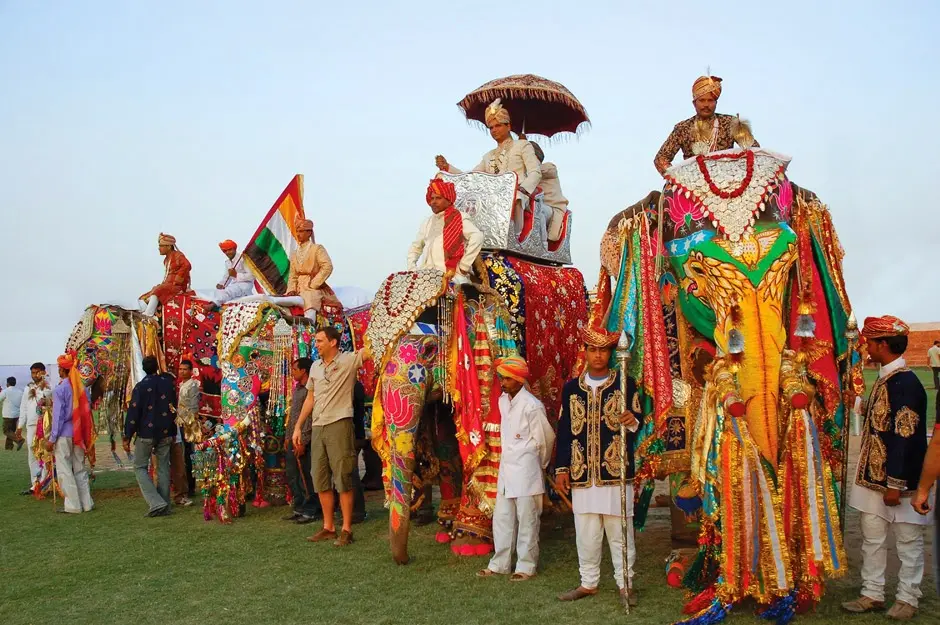Elephant catwalk in Rajasthan
During Holi, the lands of kings and queens, Rajasthan came alive with the elephant festival.
On the day of Dulhendi, when the whole country was eagerly waiting for Holi, the pink city Jaipur was geared up to witness a unique fashion show– of elephants. Though it may sound strange it is true in the land of kings and queens, Jaipur. Over 90 elephants were decorated in different colours and themes by their mahouts (caretakers of elephant) to participate in the elephant festival.
It is an annual festival, where all the elephants in the city compete with each other to get best decorated elephant shield. The festival began with traditional sounding of drums followed by a procession of elephants decorated like brides with jewellery and other ornaments from trunk to tail. The catwalk was witnessed by 10,000 visitors. The best dressed elephant was given an award.
“Rajasthan has always been a state of royalty. Therefore, not only in Rajasthan but in the whole India elephant-ride was once considered a luxurious ride fit for kings, royal family and nobles. So, in order to stick to our culture we (Jaipur tourism) organise this festival a day before Holi, or Dulhendi, every year,” said Uday Pal Singh, ex-tourism officer of Rajasthan.
Also read: Teej festival in Rajasthan (travellernook.com)
Apart from the elephant show, there were many other features like Gair Dance, Matka Race, Chakri Dance, Tug-of-war (Indian vs Foreign), Kachhi Ghodi, Kalbeliya dance, Chang Dhap, Braj Ki Holi, Bum Rasia and Tribal Dance among others that kept people spellbound. This festival attracts not just Indians but also foreigners. “I learnt about this unique festival from one of my Indian friends in London. Therefore, I preferred this time to visit India,” said Thomos, who came from London for this festival only and got impressed by the decoration of elephants.
On the other hand Kolkata based businessman, Sandeep Vaharia, thought one could catch a glimpse of the entire culture of Rajasthan in this festival. He said, “Though I belong to Rajasthan and am a frequent visitor of Jaipur, this is my first chance to be here. I am amazed to see the festival. It seems that whole culture of the state is here like Chakri Dance, Langa Gayan, Tribal Dance and others.”
Among winners in various categories was Champakali who won the elephant decoration competition. Shanti came second and Rani third. While Laxmi was given a special prize because of her jeans apparel.
Also read: Agra's colonial connection (travellernook.com)
More than 10,000 people, including a fair number of foreigners thronged the festival and took part in different competition. A tug-of-war was held between Indian tourists and foreigners, which Indians won both rounds. In the Matka Race, Kenny Jurat from Australia won the first round while Round 2 of the same match was won by Kartik Parmer of Singapore. “How can we lose against foreigners on our own land,” said Sakshi a house maker, who was with the Indian side in the tug-of-war. Marcel, from Holland, said, “Though we lost the game we enjoyed it a lot.”
Also read: Delhi’s Jama Masjid: An architectural marvel (travellernook.com)
Visitors in the festival did not let go even a single chance to play Holi. Tourists mounted on elephant back sprinkled colours on each other. “It was more interesting than what I heard about it. It gave me a royal feeling, when I was sitting on the back of an elephant and playing Holi. It is going to be one of the best Holi in my life,” said 23-year-old Poonam Pasi from Delhi, who wants to visit again. The festival ended with gulal fireworks and the band recitals.
It was not only spectacular procession of elephants and cultural events that drew tourists from all over the world. Tripathi, a businessman from Kanpur was at the elephant festival just to check out how a warm state like Rajasthan, where water is scarce, maintained so many elephants. “Earlier I was surprised when I heard about an elephant festival in Rajasthan. Because it is the home of camels, I wondered how come a festival of elephants. Now I would like to appreciate the efforts of the Jaipur Tourist department because of the way they have maintained so many elephants here.”
The story was actually published in 2012.
.png)
